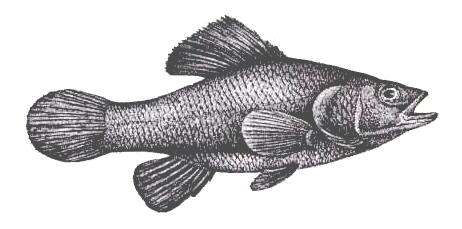One of historic New Harmony, Indiana's best known scientists was Thomas Say, known as the "father of American entomology" and as the "father of American conchology." Hundreds of species of insects and mollusks were first described by Say, so that their taxa bear his name. It is not so well known, however, that two species of fishes are also named in honor of Say.
Aphredoderus sayanus (Gilliams); Pirate Perch

A friend of Thomas Say named Jacob Gilliams lived in Philadelphia, where Say himself had resided before moving to New Harmony. A dentist, Gilliams was one of the organizers of the Academy of Natural Sciences of Philadelphia. In the Journal of the Academy (vol. IV, 1824, pages 80-82 and Plate 3), Gilliams published his only icthyological article, entitled "Description of a new species of Fish of the Linnean genus Perca."
Preceding the technical description is a remarkable introduction:
Angling some weeks ago in one of the fish ponds at Harrowgate, I had the good fortune to take three individuals of a species of Linnean Perca that was altogether new to me, and on reference to the works of the principal authors who have written on the science of Ichthyology, I have not been able to find any notice whatever of this species.I may further state the somewhat remarkable fact, that although many persons have angled frequently in the same pond, yet this fish was not known to have been previously caught there, and being desirous of securing more specimens, I have frequently since endeavoured to obtain them, but without success.
Gilliams named the species Scolopsis sayanus, but since then the species was removed from Scolopsis and placed in the genus Aphredoderus, within the family Aphredoderidae. This comparatively very old species is the only surviving member of its family.
The world's first scientific drawing of Aphredoderus sayanus appeared in Gilliams's article and appears here. The artist was Charles-Alexandre Lesueur, who knew both Gilliams and Say in Philadelphia, and arrived, along with Say, in New Harmony, Indiana, in 1826.
For more information on the Aphredoderus sayanus, or pirate perch, click on Ray Katula's link (below).
Dasyatis say (Lesueur); Bluntnose Stingray

On July 1, 1817, Charles-Alexandre Lesueur read his research entitled "Description of three New Species of the Genus Raja," at a meeting of the Academy of Natural Sciences of Philadelphia. The article was then published in the Journal of the Academy, volume 1, pages 41-45. In his article, Lesueur gives the first description of a fish to which he assigns the name Raja Say, honoring his friend and colleague, Thomas Say.
The image shown here is Lesueur's sketch of this species. Following a technical description, Lesueur writes:
The largest specimen I have seen was eighteen inches long, exclusive of the tail; sixteen or seventeen inches in the greatest width, and four or five inches thick. These dimensions varied somewhat in several individuals which I examined on the bay shore of Egg Harbour, New Jersey.
As often happens after the earliest description of a new species, later taxonomists determine that the species belongs to a different genus. The genus Raja today consists largely of skates, not stingrays. The present taxon for the species which Lesueur called Raja Say is Dasyatis say.